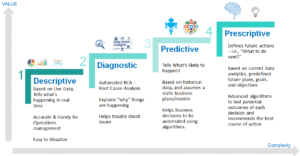What is Data Analytics?
Data Analytics refers to the systematic process of examining data to extract meaningful insights, patterns, trends, and conclusions that help in decision-making. It involves various techniques and tools to clean, transform, and model data for discovering useful information and supporting business strategies.
Today, organizations across industries use data analytics to optimize operations, enhance customer experiences, improve performance, and predict future trends. It’s a cornerstone of data-driven decision-making.
Types of Data Analytics
Data analytics is generally categorized into four major types, each with a different purpose and complexity level. Understanding these types helps businesses select the right analytical approach based on their goals.

1. Descriptive Analytics – "What happened?"
Descriptive analytics answers the most basic question: what happened in the past?
- It uses historical data to identify patterns and summarize key metrics.
- Tools like dashboards, reports, and data visualizations help represent this data clearly.
- For example, a sales report showing monthly revenue growth is descriptive analytics.
Purpose: To summarize past performance and provide insight into what has occurred.
2. Diagnostic Analytics – "Why did it happen?"
Diagnostic analytics digs deeper into the causes of trends or outcomes found in descriptive analytics.
- It uses techniques such as drill-down, data mining, and correlation analysis to explore reasons behind past events.
- For instance, if website traffic drops, diagnostic analytics might reveal that a change in SEO strategy led to the decline.
Purpose: To understand the reasons behind historical patterns or problems.
3. Predictive Analytics – "What is likely to happen?"
Predictive analytics uses historical data combined with statistical models and machine learning to forecast future outcomes.
- It looks for patterns and trends that can indicate future events.
- Examples include predicting customer churn, forecasting demand, or identifying credit risk.
Purpose: To use data to make informed predictions about future events or behavior.
4. Prescriptive Analytics – "What should we do about it?"
Prescriptive analytics goes a step further by recommending actions based on predictions.
- It uses optimization, simulation, and advanced algorithms to suggest possible outcomes and the best course of action.
- For example, based on predicted demand, it might recommend adjusting supply chain operations or pricing strategies.
Purpose: To guide decision-making by suggesting actionable solutions.
Conclusion
Understanding the four types of data analytics is essential to knowing how data supports business decisions. As students learn how to apply these types, they’ll be better equipped to turn raw data into strategic value—making them valuable assets in any industry.